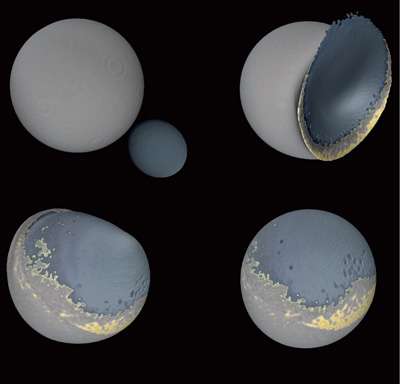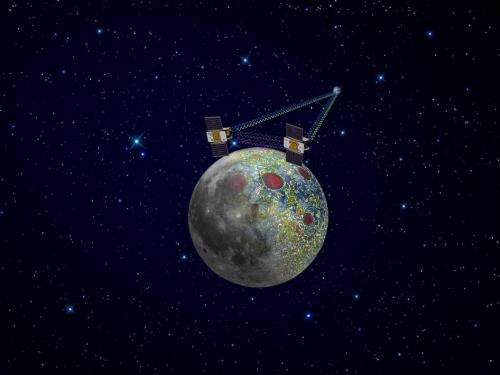GRAIL and the mystery of the missing moon

(PhysOrg.com) -- As early as Sept. 8th, NASA's GRAIL mission will blast off to uncover some of the mysteries beneath the surface of the Moon. That cratered gray exterior hides some tantalizing things – even, perhaps, a long-lost companion.
If a paper published recently in the journal Nature* is right, two moons once graced our night skies. The proposition has not been proven, but has drawn widespread attention.
"It's an intriguing idea," says David Smith, GRAIL deputy principal investigator at the Goddard Space Flight Center. "And it would be a way to explain one of the great perplexities of the Earth-Moon system – the Moon's strangely asymmetrical nature. Its near and far sides are substantially different."
The Moon's near side, facing us, is dominated by vast smooth 'seas' of ancient hardened lava. In contrast, the far side is marked by mountainous highlands. Researchers have long struggled to account for the differences, and the "two moon" theory introduced by Martin Jutzi and Erik Asphaug of the University of California at Santa Cruz is the latest attempt.
Scientists agree that when a Mars-sized object crashed into our planet about 4 billion years ago, the resulting debris cloud coalesced to form the Moon. Jutzi and Asphaug posit that the debris cloud actually formed two moons. A second, smaller chunk of debris landed in just the right orbit to lead or follow the bigger Moon around Earth.
"Normally, such moons accrete into a single body shortly after formation," explains Smith. "But the new theory proposes that the second moon ended up at one of the Lagrange points in the Earth-Moon system."
Lagrange points are a bit like gravitational fly traps. They can hold an object for a long time--but not necessarily forever. The second moon eventually worked its way out and collided with its bigger sister. The collision occurred at such a low velocity that the impact did not form a crater. Instead, the smaller moon 'went splat,' forming the contemporary far side highlands.
In short, the lunar highlands are the lost moon's remains.
"By probing the Moon's gravity field, GRAIL will 'see' inside the Moon, illuminating the differences between the near and far sides."
GRAIL will fly twin spacecraft around the Moon for several months. All the while, a microwave ranging system will precisely measure the distance between the two spacecraft. By watching that distance expand and contract as the pair fly over the lunar surface, researchers can map the Moon's underlying gravity field.
"These measurements will tell us a lot about the distribution of material inside the Moon, and give us pretty definitive information about the differences in the two sides of the Moon's crust and mantle. If the density of crustal material on the lunar far side differs from that on the near side in a particular way, the finding will lend support to the 'two moon' theory."

But this information is just one "piece of the jigsaw puzzle." To prove a sister ever existed, other pieces are needed. NASA's Lunar Reconnaissance Orbiter has already provided key information on the Moon's surface topography. Scientists can also refer to lunar surface chemistry data and look at old seismic information from Apollo for clues.
But what's really needed, says Smith, is a sample return mission to the far side to determine the ages of rocks there.
"The smaller moon, if there was one, was about 1/3 the size of our current Moon. So upon collision it would have cooled down faster, and the rocks on the far side, where its remains are thought to have spread, would be older than the ones on the near side."
In any case, we have something new to think about. Shall we try singing "fly me to the moons" or "shine on harvest moons"?
"Don't go changing any song lyrics just yet," says Smith.
More information: * Jutzi, M. & Asphaug, E. Nature 476, 69-72 (2011).
Provided by JPL/NASA



















